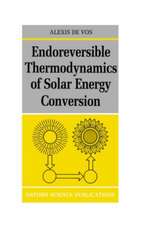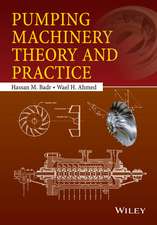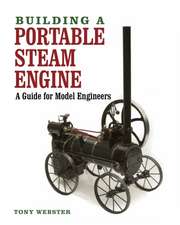Combustion and Pollution Control in Heating Systems
Autor Victor I. Hanbyen Limba Engleză Paperback – 4 apr 1994
Preț: 380.07 lei
Nou
Puncte Express: 570
Preț estimativ în valută:
72.75€ • 79.05$ • 61.15£
72.75€ • 79.05$ • 61.15£
Carte tipărită la comandă
Livrare economică 21 aprilie-05 mai
Preluare comenzi: 021 569.72.76
Specificații
ISBN-13: 9783540198499
ISBN-10: 3540198490
Pagini: 156
Ilustrații: X, 144 p. 5 illus. in color.
Dimensiuni: 155 x 235 x 8 mm
Greutate: 0.23 kg
Ediția:Softcover reprint of the original 1st ed. 1994
Editura: SPRINGER LONDON
Colecția Springer
Locul publicării:London, United Kingdom
ISBN-10: 3540198490
Pagini: 156
Ilustrații: X, 144 p. 5 illus. in color.
Dimensiuni: 155 x 235 x 8 mm
Greutate: 0.23 kg
Ediția:Softcover reprint of the original 1st ed. 1994
Editura: SPRINGER LONDON
Colecția Springer
Locul publicării:London, United Kingdom
Public țintă
Professional/practitionerCuprins
1 The Combustion of Hydrocarbon Fuels.- 1.1 Introduction.- 1.2 The Combustion Process.- 1.3 The Complete Combustion Reaction.- 1.4 Quantification of the Combustion Reaction.- 2 Stoichiometric Calculations.- 2.1 Applications of the Combustion Equation.- 2.2 Combustion Air Requirements — Gaseous Fuels.- 2.3 Flue Gas Composition — Gaseous Fuels.- 2.4 Combustion Air Requirements — Solid and Liquid Fuels.- 2.5 Combustion Products — Solid and Liquid Fuels.- 2.6 Practical Significance of the Flue Gas Composition.- 2.7 Sub-stoichiometric Combustion.- 2.8 Problems.- 3 Heat Release in Combustion.- 3.1 Introduction.- 3.2 Constant-pressure Combustion.- 3.3 Enthalpy of a Mixture of Gases.- 3.4 Enthalpy of Combustion.- 3.5 Constant-volume Combustion.- 3.6 Internal Energy of Combustion.- 3.7 Relationship between ?H25 and ?U25.- 3.8 Calorific Values.- 3.9 List of Symbols.- 3.10 Problems.- 4 Flame Temperature.- 4.1 Energy Balance on a System.- 4.2 Adiabatic Flame Temperature.- 4.3 Specific Heats of Gases.- 4.4 Calculation Algorithm.- 4.5 Calculated Adiabatic Flame Temperatures.- 4.6 References.- 4.7 List of Symbols.- 4.8 Problems.- 5 Equilibrium Composition of Flames.- 5.1 Introduction.- 5.2 Chemical Equilibrium.- 5.3 Calculation of the Equilibrium Composition.- 5.4 Dissociated Flame Temperature.- 5.5 Dissociation with Hydrocarbon Fuels.- 5.6 References.- 5.7 List of Symbols.- 6 Efficiency of Combustion Plant.- 6.1 Plant Efficiency.- 6.2 Direct Determination of Efficiency.- 6.3 Inferential Measurement of Efficiency.- 6.4 Efficiency and Flue Gas Temperature.- 6.5 Flue Gas Dew Point.- 6.6 Efficiency of a Condensing Boiler.- 6.7 References.- 6.8 List of Symbols.- 6.9 Problems.- 7 Gaseous Fuels.- 7.1 Introduction.- 7.2 Natural Gas.- 7.3 Town Gas (Coal Gas).- 7.4 LiquefiedPetroleum Gas (LPG).- 7.5 Combustion of Gaseous Fuels.- 7.6 Gas Burners.- 7.7 References.- 7.8 List of Symbols.- 8 Liquid Fuels.- 8.1 Occurrence and Processing.- 8.2 Properties of Oil Fuels.- 8.3 Combustion of Liquid Fuels.- 8.4 Pressure Jet Burners.- 8.5 Rotary Cup Burners.- 8.6 Twin-fluid Atomisers.- 8.7 Storage of Liquid Fuels.- 8.8 References.- 9 Solid Fuels.- 9.1 Introduction.- 9.2 Coal Classification.- 9.3 Coal Properties.- 9.4 Coal Combustion.- 9.5 Coal Storage and Handling.- 9.6 References.- 10 Emissions from Combustion Plant.- 10.1 Environmental Considerations.- 10.2 The Greenhouse Effect.- 10.3 Carbon Dioxide Emissions.- 10.4 Carbon Monoxide.- 10.5 Oxides of Nitrogen.- 10.6 Oxides of Sulphur.- 10.7 Particulate Emissions.- 10.8 List of Symbols.- 10.9 References.- 11 Flues and Chimneys.- 11 Functions of the Flue System.- 12 Chimney Heat Transfer.- 13 Pressure Loss.- 11.4 Chimney Location.- 11.5 List of Symbols.- 11.6 References.











